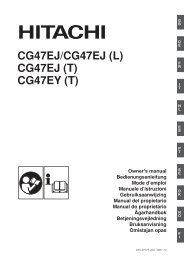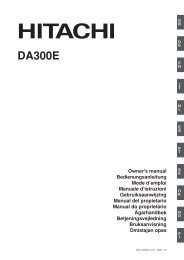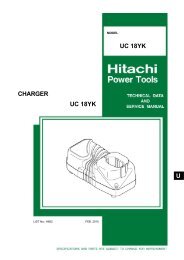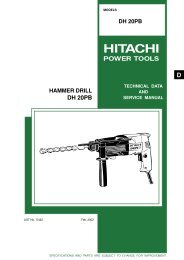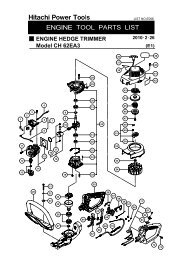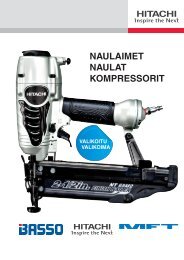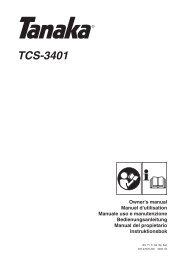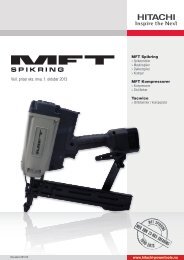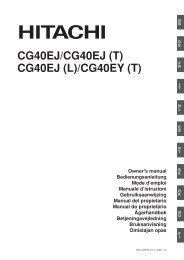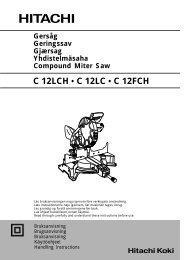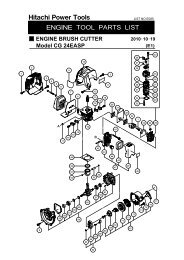CS35EK/CS38EK CS40EK/CS45EK CS33EL/CS38EL ... - Hitachi
CS35EK/CS38EK CS40EK/CS45EK CS33EL/CS38EL ... - Hitachi
CS35EK/CS38EK CS40EK/CS45EK CS33EL/CS38EL ... - Hitachi
You also want an ePaper? Increase the reach of your titles
YUMPU automatically turns print PDFs into web optimized ePapers that Google loves.
Fig.2-5<br />
Fig.2-6<br />
Fig.2-7<br />
Chain brake operation (optional) (Fig. 2-5)<br />
Chain brake (1) (If so equipped) is designed to<br />
activate in an emergency such as kick-back<br />
action. Please check to verify that it works<br />
properly before use.<br />
Application of brake is made by moving the<br />
front guard towards the bar. During the chain<br />
brake operation, even if the throttle lever is<br />
pulled, the engine speed does not increase<br />
and the chain does not turn. To release the<br />
brake, pull up the chain brake lever.<br />
How to confirm:<br />
1) Turn off the engine.<br />
2) Holding the chain saw horizontally, release<br />
your hand from the front handle, hit the tip of<br />
the guide bar to a stump or a piece of wood,<br />
and confirm brake operation. Operating level<br />
varies by bar size.<br />
In case the brake is not effective, ask our dealer<br />
for inspection and repairs.<br />
If the engine keeps rotating at high speed with<br />
the brake engaged, the clutch will overheat<br />
causing trouble.<br />
When the brake engages during operation,<br />
immediately release the throttle lever to stop<br />
the engine.<br />
WARNING!<br />
Do not carry the machine with the engine<br />
running.<br />
Stopping (Fig. 2-6)<br />
Decrease engine speed, and push ignition<br />
switch to stop position.<br />
WARNING!<br />
KICKBACK DANGER (Fig. 2-7)<br />
One of the most severe dangers when<br />
working with a chain saw is the possibility of<br />
kickback. Kickback may occur when the<br />
upper tip of the guide bar touches an object,<br />
or when the wood closes in and pinches the<br />
saw chain in the cut. Tip contact in some<br />
cases may cause a lightning fast reverse<br />
reaction, kicking the guide bar up and back<br />
toward you. Pinching the saw chain along the<br />
top of the guide bar may also push the guide<br />
bar rapidly back towards you. Either of these<br />
reactions may cause you to lose control of the<br />
saw which could result in serious personal<br />
injury.<br />
Even though your saw has safety built into its<br />
design, you should not rely on these safety<br />
features exclusively.<br />
Know where your bar tip is at all times.<br />
Kickback does occur if you allow the kickback<br />
zone (1) of the bar to touch an object. Do not<br />
use that area. Kickback from pinching is<br />
caused by a cut closing and pinching the<br />
upper side of the guide bar. Study your cut<br />
and make sure it will open as you cut through.<br />
Maintain control when the engine is running<br />
by always keeping a firm grip on the saw with<br />
your right hand on the rear handle, your left<br />
hand on the front handle and your thumbs<br />
and fingers encircling the handles. Always<br />
hold the saw with both hands during operation<br />
and cut at high engine speed.<br />
WARNING!<br />
Do not overreach or cut above shoulder<br />
height.<br />
WARNING!<br />
Use extra caution when felling, and do not<br />
use the saw in a nose-high position or<br />
above shoulder height.<br />
CHAIN CATCHER<br />
The chain catcher is located on the power head<br />
just below the chain to further prevent the<br />
possibility of a broken chain striking the<br />
chainsaw user.<br />
WARNING!<br />
Do not stand in-line with chain when<br />
cutting.<br />
BASIC TECHNIQUES FOR MAKING FEL-<br />
LING, LIMBING AND BUCKING CUTS<br />
The intention of the following information is<br />
to provide you with the general introduction<br />
to wood cutting techniques.<br />
WARNING!<br />
This information does not cover all<br />
specific situations, which may depend on<br />
differ-ences in terrain, vegetation, kind of<br />
wood, form and size of trees, etc. Consult<br />
your servicing dealer, forestry agent or<br />
local forestry schools for advice on<br />
specific woodcutting problems in your<br />
area,<br />
This will make your work more efficient<br />
and safer.<br />
WARNING!<br />
Avoid cutting in adverse weather conditions,<br />
such as dense fog, heavy rain,<br />
bitter cold, high winds, etc.<br />
Adverse weather is often tiring to work in<br />
and creates potentially dangerous conditions<br />
such as slippery ground.<br />
High winds may force the tree to fall in an<br />
unexpected direction causing property<br />
damage or personal injury.<br />
CAUTION!<br />
Never use a chainsaw to pry or for any<br />
purpose for which it is not intended.<br />
WARNING!<br />
Avoid stumbling on obstacles such as<br />
stumps, roots, rocks, branches and fallen<br />
trees. Watch out for holes and ditches. Be<br />
extremely cautious when working on<br />
slopes or uneven ground. Shut off the<br />
saw when moving from one work place to<br />
another.<br />
Always cut at wide open throttle. A slow<br />
moving chain can easily catch and force<br />
the saw to jerk.<br />
GB-8



